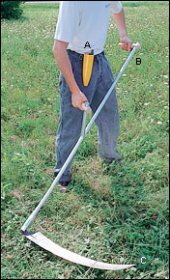
 16
16












 5
5




"To live at all is miracle enough" ~Mervyn Peake
Baryonyx Knife Co. --Owner
 15
15




r ranson wrote:
Either the end of my stroke the tip goes up - most common Or if I keep the tip down, the start of my stroke is up.
r ranson wrote:
Or if I can somehow get both start and stop of the stroke to stay at the right level, the middle bit didn't cut. It just bent. I also seem to be having a problem with keeping the blade low enough to the ground. Most of my cuts are at ankle height.
r ranson wrote:
There is a lot of grass laying over on its side. This is the mid-height stuff, just about ankle height.
r ranson wrote:
Two things I want to look up before the next scything session
1. my back feels hunched up, it seemed to get into a very rounded posture and I feel I could scythe longer if I could keep it upright.
2. can I adjust the snathe on this somehow to make it match my height better?
 4
4




 5
5




Phil Stevens wrote:two masterful replies
Phil Stevens wrote:the arc you want is different and creates a fine slicing movement.







 3
3




 7
7




 10
10











 7
7












 12
12




How Permies works: https://permies.com/wiki/34193/permies-works-links-threads
My projects on Skye: The tree field, Growing and landracing, perennial polycultures, "Don't dream it - be it! "
 6
6





 6
6




Working toward a permaculture-strong retirement near sunny Sperling.
 4
4















 4
4




Cristobal Cristo wrote:Derek,
I actually want to purchase a metal snath. When mowing between the trees last week I already broke my wooden snath 3 times. They just can not stand to mowing dense vegetation, despite all the idyllic images showing handsome people doing their scything.
Working toward a permaculture-strong retirement near sunny Sperling.
 7
7




 10
10






















 4
4





Working toward a permaculture-strong retirement near sunny Sperling.
 6
6




 8
8











 4
4











 11
11











 8
8




 8
8




 4
4











 8
8




 6
6











 5
5




 8
8






















 6
6




r ranson wrote:I feel like I have enough hours with this lee valley rig to say with confidence that this snathe was designed with the evil plan to sell more lawnmowers.
<snip>
The handles work loose with use and smooths the aluminium so that no matter how tight they are, they still slip on the snathe.
<snip>
Scything for the win.
Working toward a permaculture-strong retirement near sunny Sperling.
 6
6











 11
11




 11
11




Jim Webb wrote:Re: Handles slipping. Don't ever use a scythe with a slipping handle. As soon as it moves at all, stop and fix it before taking even one more stroke. If you keep on, you'll very soon ruin your snath.







 7
7











 8
8












|
Let me tell ya a story about a man named Jed. Poor mountain man with a tiny ad:
The new purple deck of permaculture playing cards
https://www.kickstarter.com/projects/paulwheaton/garden-cards
|






